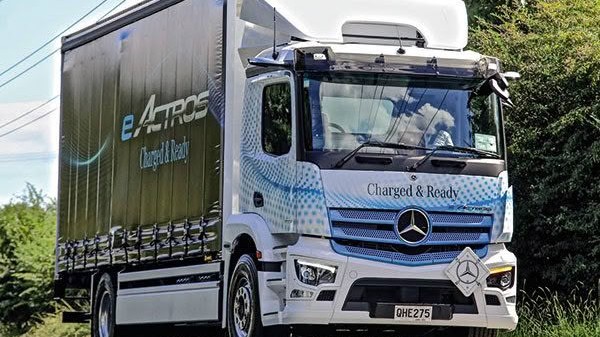
The Mercedes- Benz eActros 300 will be launched in New Zealand about the time you read this. Keith Andrews Trucks invited us for a silent, powerful, preview drive.
Buried somewhere in the Journalists’ Toolbox of Essential Field Gear is the humble voice recorder. Today, it doesn’t physically reside in a ‘toolbox’, but is a mobile app hidden in the software of our smartphones. Regardless, whenever we’re out gathering information for a story, you can be assured the round red button on the trusty voice recorder will get a prod.
The hard work starts when back in the office, listening though sometimes hours of conversation to pick out the nuggets of information and all-important quotes you eventually read on the page. And when that recorder is running in the cab of a truck, listening back can be a little more difficult with all the background road, wind and engine noise sometimes necessitating a few re-listens to properly catch what’s been said.
Not once did that happen in the two-hour voice recording of myself and Matt Gillatt, Keith Andrews’ product planning manager, as we crisscrossed South Auckland and the surrounding semi-rural roads in the Mercedes-Benz eActros 300 evaluation unit the company has been trialling since the beginning of the year in the lead up to its launch this month. Conversation was almost hushed as we cruised around with an interior noise level reduced by a claimed 10dB, equating to approximately half of the perceptible in-cabin volume – and when you’re experiencing it, you don’t doubt that for a moment.

In fact, listening back to the recording, there was more background noise to the discussions that took place as we walked round the vehicle at the Keith Andrews Wiri branch before driving off. And for the safety of those around the truck, a 60dB Acoustic Vehicle Alert System emits “a bit of a ‘spaceship’ noise”, as Matt describes it, up to 60km/h. “Sometimes, the loudest sound as the truck rolls past is the stones in the tyres,” Matt comments.
However, as we’ve discussed in the past, reduced noise levels inside and out of the truck are not the only advantages in operating an electric truck. So, what else does the eActros offer? It all starts with the name, eActros 300 – 300 referring specifically to the installed battery capacity from the three lithium-ion battery packs. Coincidentally, these offer 336kWh capacity and a range of about 300km.
“Local testing fully loaded has achieved a 300km range, with 20% battery charge remaining,” says Matt. CCS Type- 2 DC charging up to 160kW is possible, and a charge from 20% to 80% at 150kW takes 75 minutes.
“Working with customers on their charging strategy, we ask what they want to achieve, how easy that is to achieve with the truck charged up overnight, or if they must charge up somewhere in the day, and maximising the distance they want to cover. Charging is the same as refuelling. You top it up to do the kilometres you need to do,” Matt explains.
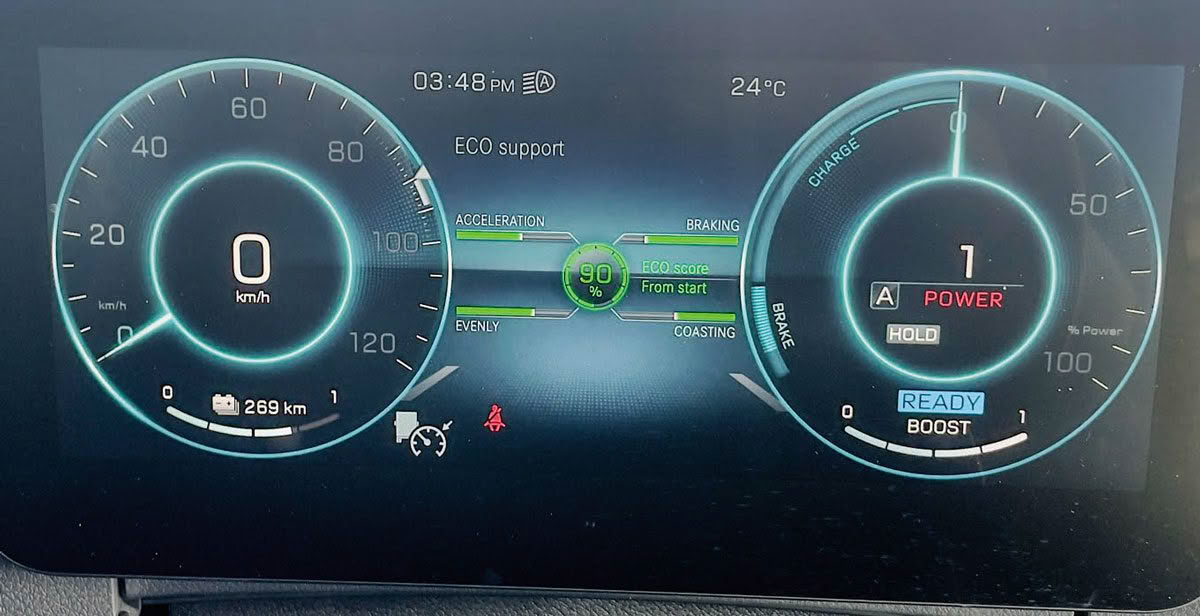

All this is done via the Mercedes-Benz range prediction tool, which accounts for the routes, climate, topography and weights, and maps out the likes of battery consumption, charging, and others. “We’ve calibrated it to New Zealand conditions, and we’re pretty confident with its accuracy,” comments Matt.
In the world of OEM electric trucks, Mercedes-Benz has differentiated itself by opting not to drop in an electric motor between the chassis rails, turning a driveshaft and a diff, but to engineer its own eAxle. This incorporates two liquid-cooled electric motors, a two-speed transmission, and the differential in the axle unit.
“It’s a point of difference for us,” Matt says. “An eAxle offers better weight distribution, because we can position the batteries better, and offers more efficient drive with fewer moving parts. It doesn’t affect axle capacities; the eActros offers the same axle limits as a diesel truck would.”
A 4×2 and 6×2 rigid, and 4×2 prime mover, will be offered at launch, all with the same eAxle.
On the point of axle weights, the topic of New Zealand’s VDAM restrictions comes up. “In Europe, these get an extra tonne [over a diesel equivalent – to make up for their heavier tare weight]. So, this has a 10-tonne tare and a 19-tonne manufacturer’s GVM.” In New Zealand, the VDAM-restricted GVM is 15 tonnes, with a payload of 4.5 tonnes. “Hopefully, we can get to higher weight limits for these trucks,” he adds. Air suspension is fitted all round.
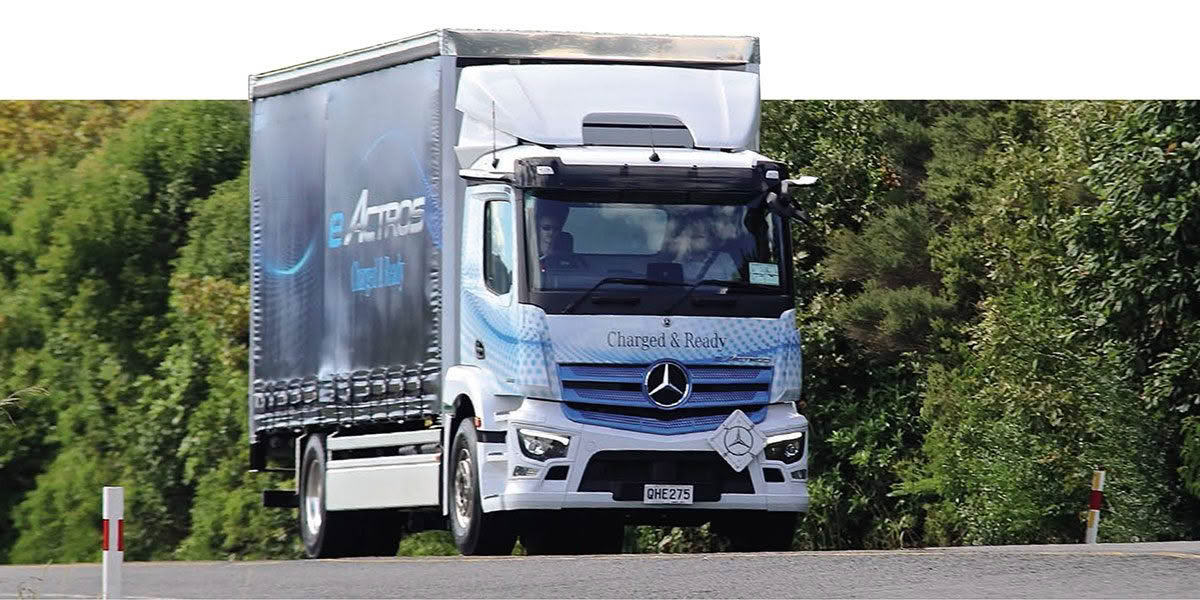
Up front, where the engine used to be, is the ‘front box’ which holds the two 12V batteries, an electric steering pump, electric air conditioning pump, and electric air compressor, among other gubbins. Immediately obvious when looking at the truck are the side-impact protection beams. The eActros complies with the ECE R100 standard for high-voltage vehicles. “The batteries are built and tested to destruction. If it detects an insulation compromise or excessive temperature in the batteries, for example, the system will shut down and it can be placed into a locked-out state. This is not a requirement in New Zealand, but we offer it,” says Matt.
Safety is of the highest priority, he explains. As part of the ‘intrinsic safety for high-voltage motor vehicles’, the eActros features trip wires at the driver’s seat, which the fire service can cut to immediately disconnect the high-voltage system and completely disable the vehicle if needed, as well as an ‘e-stop’ button within easy reach of the driver, which does the same and can also be used as a high-voltage lockout in the workshop.
However, climbing into the eActros 300’s M ClassicSpace cab (the sole option), the only button I’m interested in is the start button to the left of the steering wheel. With a press, the eActros buzzes into life, the dash lights up and the ‘Ready’ light illuminates in the left-hand dial – now a power meter – on the 10in driver’s display. As we pull out the Keith Andrews Wiri dealership, the eActros takes off with the immediate energy so familiar of electric vehicles. The eAxle offers up 400kW (536hp) peak and 330kW (443hp) continuous output, and heading toward the motorway, you wouldn’t guess we’re loaded up to max GVM (VDAM).
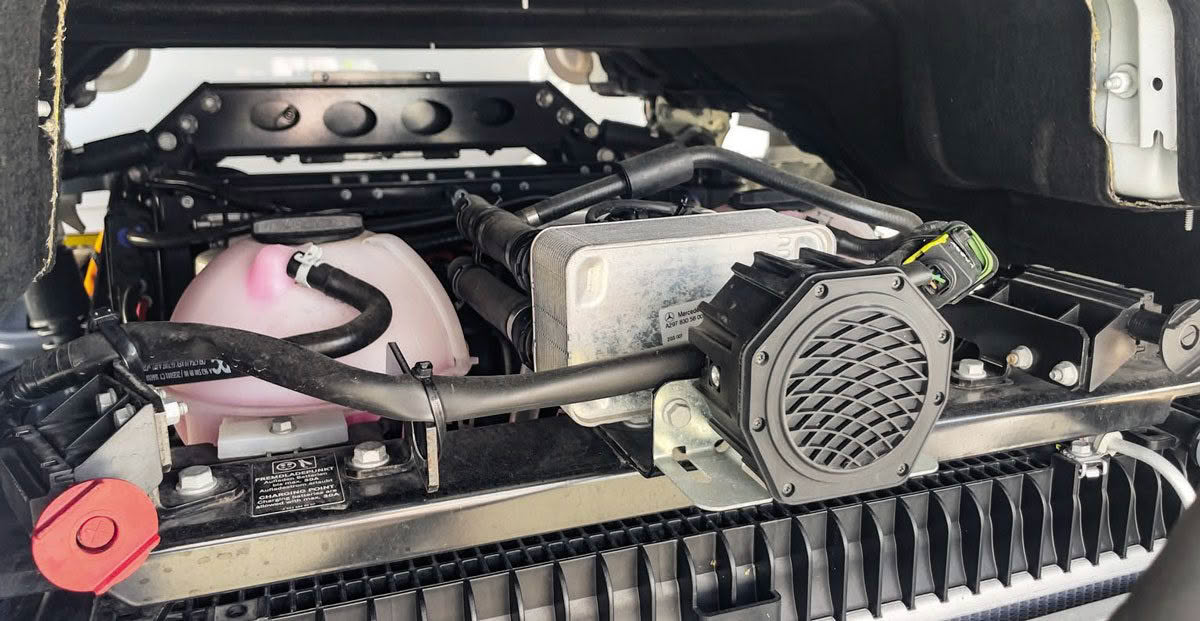
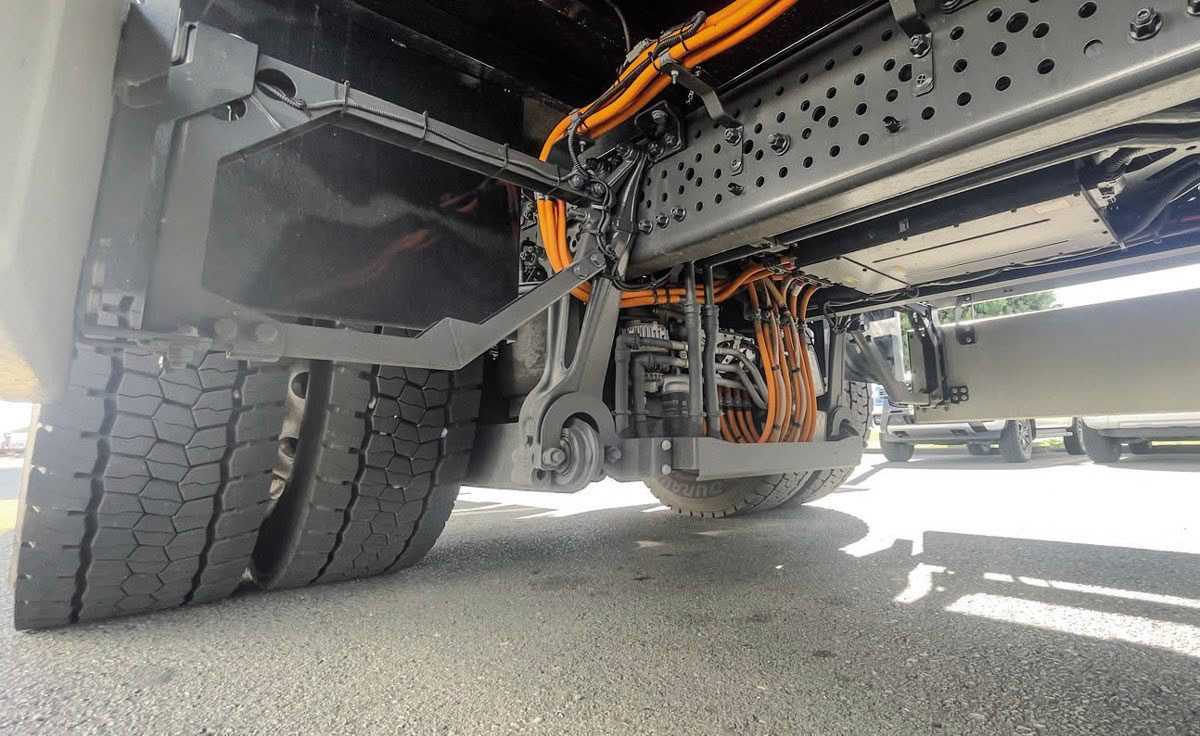
We’re set up in one-pedal driving mode, meaning lifting slightly off the accelerator will let the truck glide along; lifting off more will engage energy recouperation, slowing you down. The five levels of recouperation are selected by the traditional right-hand exhaust brake wand. When using the brake pedal, the truck slows with recouperation first before getting into the foundation brakes. The pedal travel is long but there’s a lot of ‘braking’ power before the need for the foundation brakes arises – if it does. All the while, the power meter indicates what the drivetrain is doing and where the energy is going.
It’s not as complicated as it may sound, and the recouperation braking is so natural, you get used to it very quickly. If anything, it’s the acceleration that needs getting used to. There is no hesitation and the eActros jumps off the line if you’re hard on the throttle.
The transmission shifts at 30km/h with a slight pause, and the second ratio carries you all the way to 90km/h. At full highway speed, the wind is the loudest noise (round town, it’s the sound of passing vehicles).
Slowing for traffic on the motorway, I turn off the recouperation and just let the truck roll along using its inertia. How long it’ll roll for is amazing, too, with no mechanical resistance to fight.
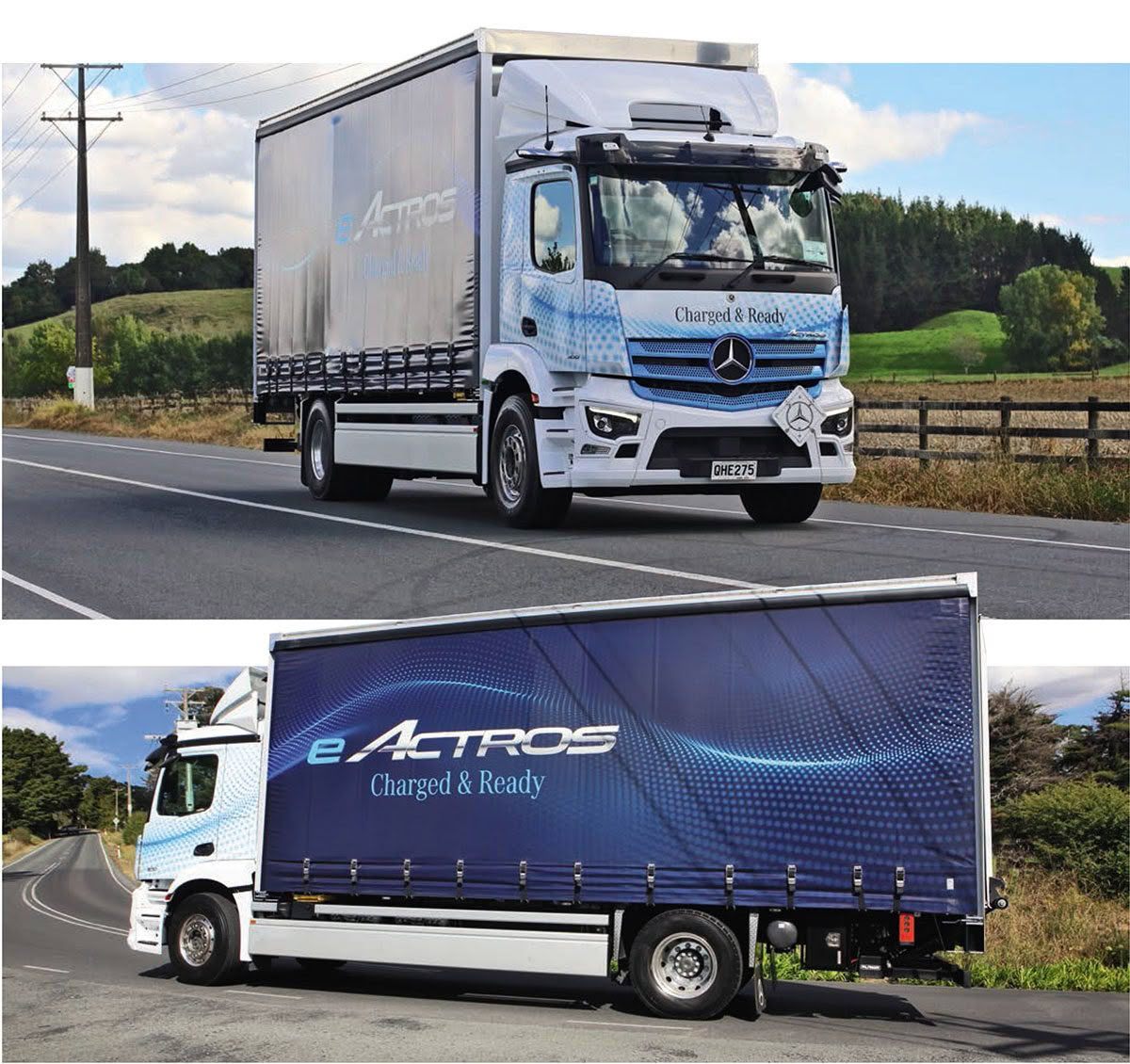
We turn off to tackle the semi-rural roads around Whitford, Brookby and Ardmore and the eActros is as easy to drive here as a car. We try a hill start, and the eActros steps off and holds first gear until the climb begins to level out, not shifting before it knows the second ratio won’t lose the momentum. Flicking the powertrain into ‘power’ mode unleashes the full 400kW (for a while, in the interest of heat management). Conversely, flicking it onto ‘range’ limits max output and max speed.
Truly, I could’ve driven around for hours playing with all the different driving modes and scenarios.
“Driver training is important with these vehicles,” says Matt. “People have been driving diesel vehicles for a long time, so they get it very quickly when they start driving a new truck. With this, it’s about driving efficiently, using the recouperation to put the energy back into the batteries … Our driver-trainers teach foresight driving, looking as far down the road as you can to make decisions far ahead of time, so that the glide mode and recouperation braking can be used as much as possible. If you’re slick, the brake pedal will be used just for coming to a standstill.”
At launch, the eActros will come with a warranty of six years/360,000km, or 18,000 charge cycles on the batteries, so operators should have full confidence in the vehicle.
“It’s about bums in seats. We need to show it operates largely like a normal Actros, and it’s easy to drive and comfortable,” says Matt. Other than being electric, it really is Actros as we know it, and that familiarity will surely be an advantage.
“The eActros 600 shows there’s no turning back, it’s designed to be an electric vehicle and it’s quite a way off for our market. The eActros 300 is available to us now. It has its market segment – metro, inter-regional, golden triangle – and we just need to focus on that.”
An eActros rolling silently up and over the Kaimais? That’s when things will really start getting interesting.









